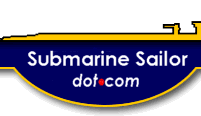|
The American Prisoners of War Rescued after the sinking of the
Japanese transport, Shinyo Maru, by the USS Paddle, SS 263, on 7 September
1944.
by Eugene A. Mazza, ROSUB@AOL.COM,
15 FEB 2004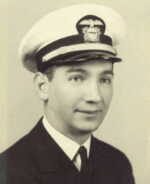 (photo
to right) (photo
to right)
I believe that there were four stages that the prisoners were exposed to. The
first stage is the capture or surrender of the person or persons. The second
stage is the treatment of the men and women while in a Japanese prison or work
camp. The third stage is the transfer by forced march or transport to other
camps or to the Japanese homeland. The fourth and final stage is the rescue and
return to the American way of life.
The history of the first three stages is well covered by many books. I
concentrated on three. “ WITH ONLY THE WILL TO LIVE” edited by Robert S.
LaPorte, Ronald E. Marcello and Richard L. Himmell, “ PRISONERS OF THE
JAPANESE” by Gavan Daws and “The Shinyo Maru Survivors Reunion, 7 September
1998 at San Antonio, Texas Booklet.” These books describe the life of the
prisoners and the brutal treatment, as they were used as slave labor, and their
constant battle with hunger and disease. I will cover very little of this
history. Stage 3, the transportation of the prisoners, from camp to camp and to
Japan via Japanese transports, is well covered by the book “ Death on the
HELLSHIPS”, by F. Michno and others. [1] In
the fourth stage, I will attempt to list the names and some history of the
Prisoners of War that were on the Shinyo Maru, when the USS Paddle, SS263 sunk
the ship in 1944. Some of these men swam 3 or 4 miles to a nearby island and
later were evacuated by the USS Narwhal SS 167.
“The Japanese were not directly genocidal in their POW camps. They did not herd
their white prisoners into gas chambers and burn their corps in ovens. But they
drove them toward mass death just the same. They beat them until they fell,
then beat them for falling, beat them until they bled, then beat them for
bleeding. They denied them medical treatment. They starved them. When the
International Red Cross sent food and medicine, the Japanese looted the
shipments. They sacrificed prisoners in medical experiments. They watched them
die by the tens of thousands from diseases of malnutrition like beriberi,
pellagra and scurvy and from epidemic tropical diseases: malaria, dysentery,
tropical ulcers, and cholera. Those who survived could only look ahead to being
worked to death. If the war had lasted another year, there would not have been
a POW left alive.” [2]
“In a Japanese prison camp, under guards holding life-or-death power, what was
it going to take to stay alive, stay sane, stay human? When a body is savagely
beaten, what happens to the mind and to the spirit? Among starving men, can
common human decency survive? What is the calorie count on friendship, on
personal loyalty, on moral agreements, on altruism? In prison camp, what would
it mean to say that a man is his brother’s keeper?” [3]
“Every POW saw men like himself die horribly. Every POW saw men like himself
offer themselves up to death so that others might live. Those who survived had
to struggle to keep themselves alive in the camp, and then struggle to live
with themselves, back in the world;they were branded by the experience. They
have borne the tribal scars of the POW ever since.” [4]
“Now we come to the movement of the POWs from camp to camp or the homeland of
Japan to work as slaves. The Japanese state that about twenty-five ships
carrying POWs, from various nations, were either bombed or torpedoed. These
ships were not marked in any way to designate them as transporting POWs. The
Japanese put them in a convoy as any other ship. Without markings, the U. S.
Submarine Captains assumed that he had a prime target.
According to Japanese figures, of the 50,000 POWs they shipped, 10,800 died at
sea. Going by Allied figures more Americans died in the sinking of the Arisan
Maru than died in the weeks of the death march out of Bataan, or in the months
at Camp O’Donnell, which were the two worst sustained atrocities committed by
the Japanese against the Americans. More Dutchmen died in the sinking of the
Jun’yo Maru than in a year on the Burma-Siam railroad. The total deaths of all
nationalities on the railroad added up to the war’s biggest sustained Japanese
atrocity against Allied POWs. Total deaths of all nationalities at sea were
second in number only to total deaths on the railroad. Of all POWs who died in
the Pacific war, one in every three was killed in the water or by friendly
fire.” [5]
Naturally the prisoners did not know anything about what was happening on the
open seas. The Japanese were still loading the prisoners, into unmarked
transports, so that they could be shipped to another camp or to Japan. Without
the knowledge that the transports were carrying POWs, the submarine Captains
and the Bombers continued the sinking until there was nothing to sink.
So the POWs, who suffered so much on land, suffered again at sea. They died in
the holds, of starvation., suffocation, dehydration, and disease and with no
sanitation. They were killed by bombs and torpedoes aimed at them by the
allies, their countrymen. When the men tried to leave the sinking ship, the
Japanese fired on them or threw hand grenades at them. If anyone was lucky
enough to survive this the Japanese in lifeboats would kill them in the water,
or they drowned, or they died on the rafts. Or, most terrible of all they
killed each other.
Now we come to the action of the USS Paddle, SS263, on her fifth war patrol. On
7 September 1944, under the command of Captain Byron Nowell.
The USS Paddle after her fourth war patrol had her refit at Fremantle,
Australia. Her fifth patrol was scheduled from 22 August –25 September 1944.

USS Paddle SS-263
“While in her patrol area, about ten miles north of Sindangan Point, Mindanao,
she sighted a small convoy. The convoy was made up of a medium tanker, two
medium AK’s, two small AK’s, two torpedo boats or DE type escorts and one small
coastal tanker type craft. There were two planes overhead. The tanker was a
medium sized modern vessel half loaded. The two AK’s were new looking ships
with two single stack masts, one fairly low stack. ALL VESSELS DID NOT SHOW ANY
UNUSUAL MARKINGS. No identification as to name was attempted because all
periscope observations were very brief with flat calm sea prevailing. Four
torpedoes were fired at the tanker with two hits. Two were fired at the leading
AK, the boat had to dive deep as the escorts turned toward the boat. Damage to
the tanker and AK could not be seen. However, loud, characteristic, breaking up
noises were heard almost immediately and continued on for sometime after the
depth charging started. Commenced taking a total of 45 depth charges and bombs,
none close enough to do any major damage, but jarring the boat considerably.
No. 43 was very close. The attack lasted about two hours and then the boat came
to periscope depth and started patrolling again.” [6]
I was able to contact a shipmate who was a crewmember of USS Paddle on her fifth
war patrol, Godfrey J. Orbeck., CPhM. This is his recollection of this action.
“ We attacked a convoy about a mile or two off Sindangan Point, Mindanao on 7-8
September 1944. We got two torpedo hits on the lead ship, a tanker and two hits
on the second ship in the column. We the crew of Paddle [SS 263] were unaware
that the Shinyo Maru was carrying POWs [750 of them] until after the war. The
escorts, the Captain identified one of them as a Q ship were dropping depth
charges immediately.
The Skipper ordered deep submergence immediately, but we were light forward, due
to the departure of four fish from the forward room. The Skipper ordered all
hands, those not engaged in ship’s tasks, to the forward torpedo room since we
could not use the trim pump at that time.
By the time I got to the forward room, the men of the crew occupied most of the
space. I crawled over several men got an unused torpedo skid, which I laid on
and later went to sleep. I was standing night watches in the conning tower from
midnight to sunrise so day time hours was sleeping time for me.
The Skipper of the tanker ran his ship up on the beach to keep her from sinking.
They had a machine gun on the stern, which was manned by a Jap gunner who was
shooting at the heads of the U. S. Prisoners in the water. Japs in the
lifeboats were also shooting at the POWs and would not permit U. S. personnel
to get aboard the lifeboats.
Paddle stayed deep until the depth charging
was over, then we surfaced, reloaded tubes and put in a battery
charge. Paddle proceeded northward along the coast looking for the
tanker. We were unaware that she had been beached. We had heard
breaking up noises from only one ship, the Shinyo Maru. The Skipper
wanted to finish off the tanker.
Unknown to us 83 POWs made it to the beach. One died on the beach. “The 83rd man
was known as Tennessee. But no one seems know to what his real name was. He
died about two days after we came ashore, and was buried on the hill in back of
the town Sindangan.”8So there were only 82 survivors. The Paddle crew did not
find out about the POWs until after the war. The skipper told Orbeck, that he
did not learn about the POWs until he went to the Bureau to check on his orders
in 1946.
Friendly Filipinos helped the 82 survivors. Most all were clothed only with a
G-string. Within a few days the survivors made it inland to a guerilla group,
back in the jungle commanded by a U. S. Colonel named McGee. General McGee had
been a member of a POW group, some weeks earlier, but escaped and formed the
guerilla group in the jungle. General McGee’s group had sent a radio message to
the U. S. forces in the south about the 82 survivors.
The USS Narwhal SS167 was assigned to pick up these men.”9 The USS Narwhal [V 5]
SS167, under the command of Commander Jack C. Titus departed on her fourteenth
war patrol on 14 September-5 October.

USS Narwhal SS-167
The USS Narwhal [V 5] SS167, under the command of Commander Jack C. Titus,
departed on her fourteenth war patrol on 14 September-5 October 1944. On the
27th of October she deposited men and stores on the island of Cebu. She then
took off and on the 29th picked up the 81 surviving POWs from the sinking of
the Japanese AK by the USS Paddle. “The Narwhal after seeing security signals.
Surfaced with small boat in sight flying U. S. Ensign. Captain Thomas, A.U.S.
[the representative of the area commander] came on board. At his request moved
into Siari Bay. This is a poor location due to currents, shoal water and lack
of protection. This is probably the first day in the past five that boating
would have been feasible here, with conditions almost perfect for this season.
Recommend the eastern side of Sindangan Point for future operations. Boats
alongside. Put two rubber boats in the watered manned by reliable petty
officers to bring back stretcher cases, 81 survivors and 1 doctor on board.
These survivors were prisoners of war being moved north from Davao when the
transports were torpedoed about 6 September. Four of them were stretcher cases.
Gave shore party flour, coffee and lubricating oil. Took on board official
mail. Backing Clear. Made trim dive.” [10]
Survivors of Shinyo Maru sunk 7 September 1944 near
Liley, Sindangan, Province, Mindanao. Philippines:
 BOOTH, JOHN, US Navy,
QM, died 10 Feb. 2000; BOOTH, JOHN, US Navy,
QM, died 10 Feb. 2000;
Clabourn, Charles V. US Navy, died 16
Nov. 1986, 3038 Mink Pt. Blvd., Beaufort, SC. 29902;
Parker,
Buster, US Navy, QM, Unknown;
Waters, Arthur D. US Navy, PTN,
died 29 Aug. 1998, 15511
Watson, Madera, CA. 93638;CLEM,
Onnie E., US Marines, 4TH Marines, 6027 Glendora, Dallas, TX.
75230;
Cutter, Verle D., US Marines, 4TH Marines, died 16 Feb.
1987, PO Box 76, Needles, CA. 92363;
The following were from the US Air Force
Billick, Rae E., died 1 Feb. 1976;
Brownung, Paul L., died
13 Oct. 1982;
Dale, Eugene R., died 1946,
Donohoe, Jack M.,
21st Pur AF, 2223 West Garland, Spokane, WA. 99205;
Frederick,
William T., died 4 Jan. 1989, 610 S. Wayside, Anaheim, CA. 92805;
Gardner, Walter E., died 27 May 1983;
Gillespie, John
P.,17th Pur AF,301 White Oak Drive, Santa Rosa, CA., 95409;
Golino, Peter J., died 15 Dec.1994, 5200 Irvine Blvd., Irvine,
CA. 92720;
Grantz, Donald J., died 7 Oct. 1987;
Greene,
James R.,19th BG AF,369 Taylor Road, Suwanee, GA. 30174;
Kirker,
Robert J., died 23 Sept. 2001, 9495 CummingsRd., Durham, CA. 95938;
Lorton, Bill J., 2672 Broadview, Medford, OR. 97501; McClure,
Cecil H., died 21 May 1989;
McPherson, Donald I., died 28 Dec. 1973;
Morrett, Rev. John J. FA, PO Box 1148, Kapaau, HI.
96755;
Radcliff, Otis E., died 18 Nov. 1978, 4813 Vick St.,
Portsmouth, VA. 23701;
Robinette, George R., died 1952, 6900
Almond Ave., Orangevale, CA. 95662;
Schwartz, Bert, PO Box 1309
Blairsville, GA. 30512;
Sneddon, Murray M., died 3 March 1950,
2431 Cheyenne Drive, Bishco, CA., 93514;
The following were in the Medical Corps
Bier,
Jessie, died 6 Jan. 2001; Latham, Calvin E., died 29 Dec. 1980;
Simkins, Marcus N., died 17 June 1964;
The following were in the Infantry
Cain,
William P., death unknown; Cook, Richard L., died 1945;Hall, Willard
E. died 28 Oct. 1985;
Johnstone, Charles C., died 4 AUG. 1994,
PO Box 622 Grizwald Plaza, Erie, PA., 16512;
Kuskie, Glen E.,
death unknown, 85290 Glenada Road, Florence, OR. 97439;
Lamkin,
Joseph C., died 18 July 1964; Motsinger, Emery A., died 7 June 1983;
Skinner, Harry J., died 23 AUG. 1988; Snowden, Paul S., died 3
MARCH 1950;
Stymelski, John ; Treski, Edward S. 4505 Crepe
Myrtle, Columbus, SC., 29206;
Vann, James K., died March 1988;
The following were in Ordnance;
Alexander, Walter N., 440TH
Ord., died 18 May 1999, 1363 Engle Street, Aurora, CO., 80011;
Bennett, John R., 44TH Ord., died 15 June 1983, 151 Sycamore
Ave. Bethpage, NY. 11714;
Biddle, William E. 17TH Ord., died 5
March 1989, 2405 Cheyenne Blvd., Toledo, OH. 43614;
Ingley,
Lawrence P., died 27 Feb. 1967; Schoenborne, Omar A., died 21 Jan.
1997;
The following were in the Engineers
Caputo,
Marco. A., died 13 April 1986, 10393 Ft. Edward Road RR2, Edward, NY
12828;
Chenoweth, William C., 222 Inslee Street, San Antonio,
TX. 78209;
Fisher, Harry O., 803rd Engr., died 29 June 1973;
MacKowski, John J., 803rd Engr., died 13 Jan. 2000, PO Box 224
Maple Ave., Ghent, NY., 12075;
Pflueger, Theodore L., 803rd
Engr., 954 Sea Palm Ave., Pacific Grove, CA. 93950;
Wilson,
Harold W., death unknown;
The following were in the Air Force Battle
Group
Blakeslee, Robert B., died 5 June 1995, 3
Lexington Ave., Plattsburg, NY. 12901;
Bolitho, Hayes H., Rt.1,
Box 867, Big Sandy, TX. 75755;
Coe, Joseph P., died 7 April
1997, 1405 Suffolk Street, Sierra Vista, AZ. 83635;
Denson,
Harvey T., died 19 Dec.1996, 622 Sun Haven Drive, San Antonio, TX.
78239;
Gillin, Donald F., died 30 June 1997, 601 Lido Park
Drive, Newport Beach, CA. 92663;
Hagins, Issac, 2047 W.Maryland
Ave., Phoenix, AZ. 85015;
Hoctor, Francis, 86 Huff Road, Lyman,
ME., 04005;
Hughes, Roy J., 28TH BS 19TH BG, 1902 Lee Ave.,
Mountain Home, AR. 72653;
Johnson, Ralph R., 28TH Mat 20th BG,
4849 Waterbridge Down, Sarasota, FL. 34235;
Jones Joseph H., 701
Ord 19th BG, died 11 June 1995, 1862 Harrisburg Park, Grove City,
OH. 43123;
Knudson, Lyle G., 27TH BG, died 24 July 1999, 1411
Paramount Street, Pocotillo, IL. 83211;
Overton, Cletus O., 16TH
BS 7TH BG,1503 Pinehurst, Malvern, AR. 72104;
Person, Ralph H.,
5TH ABG, died 1990, 817 NW 52nd Street, Seattle, WA., 98107;
Russell, Roy D., 28TH BS 19TH BG, PO Box 652, Forest Hill, CA.
95631;
Steinhauser, Charles A., 20TH ABG, died 22 May 1987, 3522
Sky Haven Lane, Ocean Side,CA. 92056;
The following were in the Coast Artillery
Corps
Horabin, William S., 200 CAC, died 16 June 1999,
11709 Wind Song Cove, Austin, TX 78750;
LeClear, Francis E, died
12 Nov. 1990; Moore, Lewis S., died 4 May 1992;
Olinger, D. J.,
died 10 Dec. 1968;
Pulice, Michael, 515 CAC, 3010 Ronna, Las
Cruces, NM. 88001;
Rose, Denver R., died 6 June 1970; Sharp,
Felix C. Jr., died 2 Dec. 1997;
Shoss, Morris L., CAC PS, 3111
Nantucket Street, San Antonio, TX. 78230;
Tipton, Lawrence, died
24 Oct. 1996, 5910 64TH Street, NE, Marysville, WA., 98270-4858;
The following were in Other Units
Donlon,
James D. Jr., ART, died 9 Oct. 1995, 8545 Carmel Valley Road,
Carmel, CA. 93923;
Gallager, Fredweick J., Corps of Engineers,
died 2 Sept. 1991, 1125 N. San Nicholas Circle, Tucson, AZ.,
85704-2933;
Haskell, Willard L., Sig Corp, died 22 June 1997,
3915 W. Maryland Ave., Tucson, AZ. 85719;
Mapes, Victor L., 41
Div. Philippine Army, 717 Hollywood Ave., Silver Springs, MD. 20904;
McComas, James F., Armored, died 19 Sept. 1971, 420 N. 10TH
Street, Brainard, MN. 56401;
Playter, John C., D Bat 88 FA
Philippine Scouts, 646 N. Pike Ave., Bolivar, MO. 63613;
There was one Britisher in this
group
Gardner, James A., British 1ST lt.,
unknown. [11]
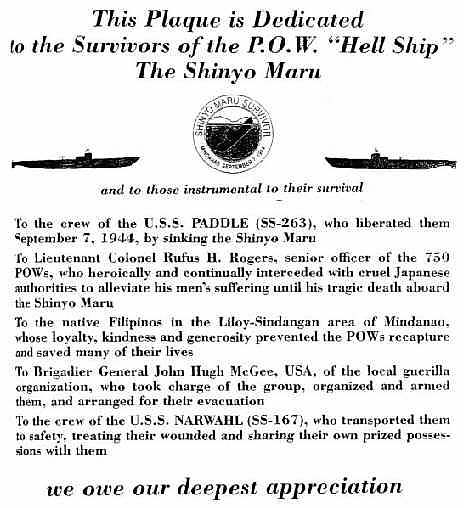
Memorial Plaque Dedication
As noted there were only eighty-three POWs that were capable of swimming or by
whatever means were capable to land on the beach. It was with great sorry that
one of their members, John J. McGee, died shortly after reaching the beach. Of
the remaining eighty-two, eighty-one were rescued, one member namely, Joseph P.
Coe refused to be picked up. His son-in law Joseph M. Meehan provided this
information.
“My father-in-law, Joseph P. Coe Jr., was on the SHINYO Maru when it was sunk on
Sept. 7, 1944. He escaped and made it to shore. He later refused to be picked
up with the other survivors and stayed on Mindanao and served as a radio
operator under the command of Brig. General Wendall Fertig. For this he was
later awarded the Bronze Star. He continued in the U. S. Army, after the war,
serving in both Korea and Viet Nam, and retired in 1976 as a Colonel. His last
assignment was as the commander of the Signal Corp Battalion at Ft. Huachuca,
Arizona. He died in 1977, I did an oral history interview with him a few years
before his death and I am working on compiling a history of his military
career.” [12]
This is a Biographic Sketch of another survivor, namely, Theodore L.
Pflueger:
“I am a member of ADBC, Inc., No.
3456. I am also a life member of EX-POW, Card No. 15930 I was in the 809th Avn
Co. in September 1941 when I came to the Philippines, and was stationed at
Nichols Field. The Company later became “C” Co., 803 Avn Engr Bn the week
before the war started. I was promoted to 1st Lt. In the Corps of Engineers the
month of November 1941.
I was on the Death March and started from about Kilometer 210 down to Marvelis
and from there to San Fernando Pampanga, where I boarded a cattle car, packed
in like sardines to Capiz and thence to O’Donnell, Marvelies. I was trucked
from O’Donnell to Camp 3, to the Airfield at Lasang; at Zamboanga, about 3
September 1944 I was transferred to the hold of the ship Shinyo Maru.
The USS Submarine Paddle, sank this Hell Ship on 7 September 1944 in Sindangin
Bay, Mindinao, PI. Most of the [about] 800 POWs died when the 2 torpedoes went
off in the holds where we were packed and the Japanese shot the rest in the
water as we were swimming away from the sinking ship. All that was left of
about 800 POWs that had been on the unmarked ship were 83 men who managed to
reach the shore near Saindangin and one man died the next day, leaving 82
survivors.
I was able to leave the Philippines by way of the USS Narwhal, and eventually
wound up in Brisbane, Australia in the Army Hospital there, along with other
survivors of the sinking Shinyo Maru. I have a complete list of the 82
survivors, [ I am one of them ] and there are 25 of these men alive today.
Contact me if you want any information from my list."
Ted Pflueger [13]
My last POW covered will be Onnie Clem. I feel that his actions
and reactions were typical of each prisoner. The information about Clem is
taken from the book “WITH ONLY THE WILL TO LIVE.”
“Onnie Clem of Texas, was a Sergeant in the U. S. Marine Corps, 3rd BAT. 4TH
REG., at Cavite Yard. Captured on Bataan and spent time at 1-Camp O’Donnell,
2-Cabanatuan and 3-Davao Penal Colony. Clem was on board one of the infamous
Death Ships when it was torpedoed a couple of miles outside Zamboanga,
Mindanao. He swam ashore, was found by Filipino guerrillas, and ultimately was
evacuated by an American submarine.”
Clem narrated the following: “ The Japanese put 250 of us in this forward hold.
And in the after hold they put another 500 men. The ship would travel a little
ways and stop; it might stop several hours and start up again. We were aboard
this ship altogether about nineteen days and eighteen nights. You had room to
sit and lay down; the food was a little better. Well, late one afternoon we
heard the Japanese bugler blowing general quarters, and in the process of
blowing it he trailed off. He just pooped out, hit some sour notes. Suddenly
the Japanese pulled the hatch covers off and dropped hand grenades down in
there and then turned machine guns down the hold. Well just about the time they
started that, there was this explosion. What had happened was that a torpedo
had hit the ship. Personally, the only thing that I remember was that I saw a
flash, and everything turned an orangish-colored red. No feeling, no nothing.
Every-thing just turned a solid color. I don’t know if the grenades went off
first or the torpedo because it all meshed together. As I said, everything
turned red on me, and I assume that’s when the torpedo hit. The next thing I
knew, I was kind of flying, just twisting and turning, and there were clouds of
smoke all around me. I couldn’t see anything but these billowy forms like
pillows. I thought I was dead.
Then I opened my eyes, and reality came back. I was underwater in the hold of
this ship, and these pillows were the bodies of other guys in there. Some of
them dead; some of them were trying to get out. The ship was filling up with
water, and I thought it had already sunk; and I thought I was trapped down in
it, and I thought I was going to die, sure enough. So I figured the quickest
way to get it over with was to go ahead and drown myself. So I opened my mouth
and thought I’d drink some water.
I found that my head was above water, and I was just gulping air. I looked up,
and I could see light coming through this open hatch. Then I thought, ‘Well , I
can get out of here.’ In the meantime, all this water was rushing up toward
this hatch, and the ship was filling up and sinking. I had actually been forced
into a corner and was away from the hatch, and this was one place where it was
everybody for themselves-survival of the fittest. Everybody was clawing at each
other trying to get to the hatch. You’d pull one person out of the way to get a
little closer to the hatch. I finally reached the hatch, and two other guys and
I pulled ourselves out at the same time.
Up on the bridge there was a machine gun spraying the hatch. A burst of
machine-gun fire caught all three of us and knocked us back down in the hold.
We’d all been hit. I got plowed in the skull. Another bullet chipped out my
chin. Nevertheless, I was able to work myself back up on deck, and I was eyeing
that bridge when I came out that time. The gun was still there, but the gunner
was laying out on deck. Somebody had apparently got up there and killed him. At
this time I found out that we were out in the ocean about two or three miles
from shore. All I had was a loincloth.
All I could think of was getting to that land and getting some water or coconut
milk. I couldn’t see out of one eye on account of the blood. I’d reach up
there, and I knew I was shot. I figured I was in pretty bad shape, buy I still
wanted to get to shore and get something to drink. You could barely see the
land.
So the first thing I thought of was that I had a long swim. I pulled off my
loincloth so that I had nothing to encumber me in swimming. Also, I had been
down in the hold for nineteen days and eighteen nights, so I didn’t have a lot
of strength. Anyway I dove over the side, and when I hit the water I happened
to look up, saw that we were part of a convoy because there were many ships
around. The other ships had putout lifeboats to pick up Japanese, but they were
shooting all the Americans. They were shooting them, or some of the officers
were taking swipes at their heads with sabers. There were Japs all around me.
Hell, there were lots of Jap troops on this ship.
Then there was a seaplane patrolling for this convoy, and we had to contend with
him. He’d make a pass and strafe us. In the meantime, I couldn’t hear a thing
because, I found out later, both my eardrums had been perforated in the
concussion of the explosion. I was as deaf as I could be, so in the swimming
all I could sense was little shocks in the water, and I didn’t know what it
was. I’d look around and the water would be spraying up, and it was where
somebody was shooting.
We swam and we swam, and my right arm just finally got to where I couldn’t swim,
I couldn’t move it, couldn’t pull it over my head. It was completely paralyzed,
useless. I found out later that while I had been swimming I’d been shot
twice—once in the arm and once in the shoulder. We got to the beach a little
before sundown. Two of us got into some trees off the beach, and a Filipino
walked up. He had on a pair of cut-off dungarees, and he took them off and gave
them to me, and then he climbed up this coconut tree and got a bunch of
coconuts and cut them down for us.
We walked about a mile inland and came upon this hut with several Filipinos
standing around. They gave us some water—I never could get enough water—and
then they took us to a village probably five or six miles away. Then they
started to bring other Americans into this village. We stayed there that night,
and there were eighty-three of us that showed up. There were 750 of us on that
ship, and only eighty-three of us got ashore.
They moved us into a main guerrilla camp about ten miles back in the hills. They
took the slugs out of my arm, but they never did take the one out of my back.
This guerrilla encampment had radio contact with Australia, and they promised
us that the next time they brought in supplies by submarine they would take out
the wounded. We were supposed to be down at the beach at a certain time. One
night after we’d been with the guerrillas about a month we went down to the
beach and this submarine surfaced and the Filipinos took us out to the sub in
dugout canoes.” [14]
Reunion: It should be noted that these POWs have had reunions.
Their last one was in San Antonio, Texas on 7 September 1998. There were
seventeen present. Some were in no condition to travel, one died in a car
accident on his way to the reunion, and some felt that it was too far to
travel. There were seventeen members and others in attendance, wives and
children of the attendees, and one of the men from the USS PADDLE, Godfrey J.
Orbeck CPhM, the submarine that sunk the Shinyo Maru . One of the widows was
there, Peter Golino’s wife. One woman who was the daughter of the Camp
Commander at Lasang, our last POW camp. Plus there were a few others that
wanted to visit with us because they had relatives that were on the Shinyo Maru
and went down with the ship. They had a welcoming letter from the Governor of
Texas, the Honorable George W. Bush. They also received the Nimitz plaque.
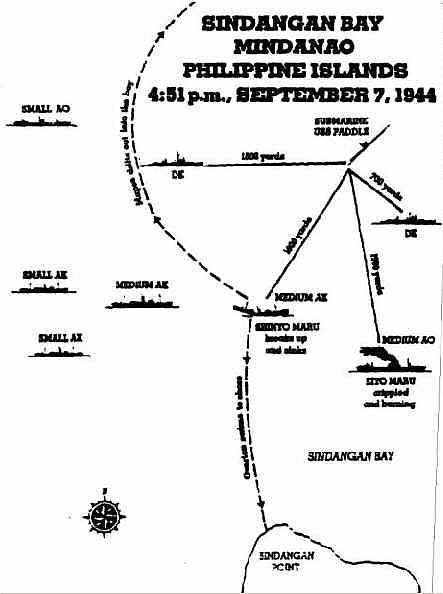
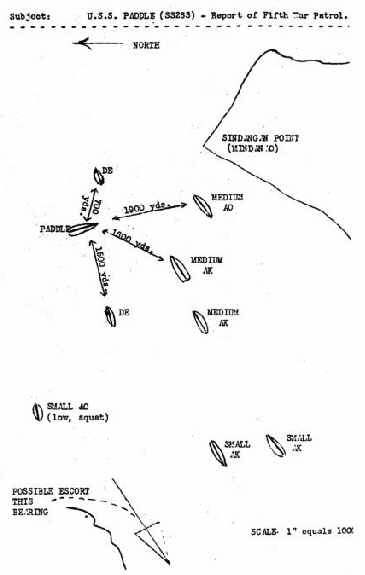 [7] [7]
Shinyo Maru Survivors
-
Bolitho, Hayes H. [Irene] Rt. 1, Box 867 Big Sandy, TX. 75755 [903] 769-3144
-
Chenoweth, William C. [Ann] 222 Inslee St. San Antonio, TX. 78209
-
Clem, Onnie E. [Julie] 6027 Glendora Dallas, TX. 75230 [214] 361-5269
-
Greene, James R. [Cornelia] 369 Taylor Rd. Suwanee, GA., 30174 [770] 963-8410
-
Hagins. Isaac B. [Janet] 2047 W. Maryland Ave., Phoenix, AZ., 85015 [602]
249-2362
-
Johnson, Ralph R. [Jeanne] 4849 Waterbridge Dr. Sarosota, FL., 34235 [941]
377-5139
-
Kirker, Robert J. [Betty] 9495 Cummings Rd. Durham, CA., 905938 [530] 343-0579
-
Lorton, Bill J. [Frieda] 2672 Broadview Medford, OR., 97501 [503] 773-4687
-
Mackowski. John J. [Opaline] Box 224 Maple Ave. Ghent, NY., 12075 [518]
392-3506
-
Morrett, Rev. John J. [Joani] PO BOX 1148 Kapaau, HI., 96755 [808] 889-5067
-
0verton, Cletus O. [Catherine] 1503 Pinehurst Malvern, AR., 72104 [501]
332-5038
-
Pflueger, Theodore L. [Lucille] 954 Sea Palm Ave. Pacific Grove, CA.,
93950-2239 [408] 375-4626
-
Playter, John C. [Mary] 646 N. Pike Ave. Bolivar, MO., 65613 [417] 326-7166
-
Pulice, Michael [Mary] 32010 Ronna Las Cruces, NM., 88001 [505] 523-6383
-
Russell, Roy D. [Toni] PO Box 652 Forest Hill, CA. 95631 [916] 367-2321
-
Schwarz, Bert [Laura] PO Box 1309 Blairsville, GA., 30514 [706] 745-5754
-
Shoss, Morris L. [Flora] 3111 Nantucket Dr. San Antonio, TX., 78230 [210]
696-7124
-
Treski, Edward S. [Formerly Tresniewski] [Wiilda] 4505 Crepe Myrtle Columbia,
SC., 29206 [803] 787-2017
-
Waters, Arthur D. [Lorraine] 15575 WATSON Madera, CA., 93038 [209] 673-6604
Representing The U.S.S. Paddle
-
Orbeck, Godfrey J. [Agnes] 158 E. 54TH STREET Minneapolis, MN., 55417 [612]
729-8495
Deceased Relatives in Attendance
-
Randell, Marjorie & Edward, [sister of Howard [IRISH] [530] 677-1812 2953
Boeing Rd, Cameron Park, CA., 95682
-
Bryant, Betty & Windell, [ sons –Mark & Kevin will attend] [903]
886-2236 2805
-
McCarley Dr., Commerce, TX., 75428 [ Daughter OF Rufus Rogers]
-
Golino, Peter J. [Helen] [714] 731-8234 5200 Irvine Blvd., Irvine, CA., 92720
Additional Attendees
-
Booth, MAYNARD B. [Dorothy], 124 Dogwood Lane, San Antonio, TX. 78213
-
Miller, William A. [Gerry], 98 Grandburg Circle, San Antonio, TX., 78218
-
Stempin, Harry & Dottie, 1 Tower Parkiane, San Antonio, TX., 78209
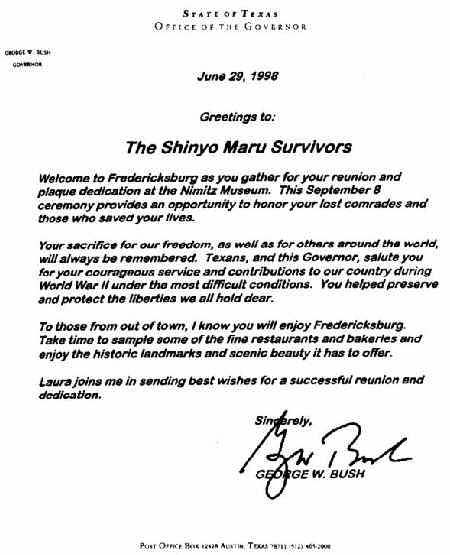
Article References:
-
[1] http://harrisonheritage.com/adbc/hellship2.htm
Michnogf@aol.com
-
[2] Prisoners of the Japanese, by Gavan Daws
-
[3] Prisoners of the Japanese, by Gavan Daws
-
[4] Prisoners of the Japanese, by Gavan Daws
-
[5] Prisoners of the Japanese, by Gavan Daws
-
[6] Excerpt from the ship log of USS Paddle SS 263 Fifth War Patrol
-
[7] Shinyo Maru Survivors Reunion , 7 September 1998, at San Antonio, Texas.
-
[8] TeePee954pg@cs.com
-
[9] Letter from Godfrey J. Orbeck, CPhM, USN.
-
[10] USS Narwhal [SS 167]- Report of Fourteenth War Patrol
-
[11] Onnie Clem email holidays@airmail.net and
http://harrisonheritage.com/adbc/pflueger.htm
-
[12] http://ussubvetsofworldwarii.org/bbs Joseph M. Meehan email address
ahsnad@infomagic.net
-
[13] Ted L. Pflueger email TeePee954pg@cs.com and
http://harrisonheritage.com./adbc/pflueger.htm
-
[14] With Only The Will To Live edited by Robert S. LaPorte, Ronald E. Marcello
and Richard L. Himmell.
-
[15] The Shinyo Maru Survivors Reunion Booklet
-
[16] The Shinyo Maru Survivors Reunion Booklet
Additional Reading/Resources:
A book on the Shinyo Maru has been written by survivor John Playten (photo
below).
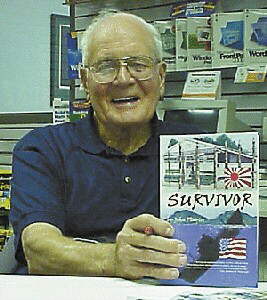
I found this on the
Connection Magazine website which states "His book can be ordered by
calling the SBU bookstore at 417-328-1530." It is not currently available
via Amazon.com - Ed 2/15/2004
If any readers have additional information on this segment of WWII submarine
history, photos, anecdotes or other input, please
contact SubmarineSailor.com
- Published on SubmarineSailor.com on 2/16/2004 -
|
